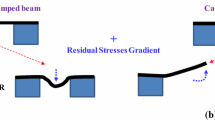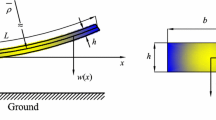Abstract
This works presents analytical expressions of the electrostatically actuated initially deformed cantilever beam problem. The formulation is based on the continuous Euler–Bernoulli beam model combined with a single-mode Galerkin approximation. We derive simple analytical expressions for two commonly observed deformed beams configurations: the curled and tilted configurations. The derived analytical formulas are validated by comparing their results to experimental data and numerical results of a multi-mode reduced order model. The derived expressions do not involve any complicated integrals or complex terms and can be conveniently used by designers for quick, yet accurate, estimations. The formulas are found to yield accurate results for most commonly encountered microbeams of initial tip deflections of few microns. For largely deformed beams, we found that these formulas yield less accurate results due to the limitations of the single-mode approximation. In such cases, multi-mode reduced order models are shown to yield accurate results.





Similar content being viewed by others
References
Abdulla SMC, Yagubizade H, Krijnen GJ (2012) Analysis of resonance frequency and pull-in voltages of curled micro-bimorph cantilevers. J Micromech Microeng 22(035014):13. doi:10.1088/0960-1317/22/3/035014
Alkharabsheh S, Younis MI (2013) Dynamics of MEMS arches of flexible supports. J Microelectromech Sys 22:216–224. doi:10.1109/JMEMS.2012.2226926
Andreaus U, Placidi L, Rega G (2013) Microcantilever dynamics in tapping mode atomic force microscopy via higher eigenmodes analysis. J Appl Phys 113(22):1–14
Chuang W-C, Hu Y-C, Lee C-Y, Shih W-P, Chang P-Z (2009) Electromechanical behavior of the curled cantilever beam. J. Micro Nanolith (MEMS MOEMS) 8:033020
Fang W, Wickert JA (1996) Determining mean and gradient residual stresses in thin films using micromachined cantilevers. J Micromech Microeng 6:301–309
Gupta RK (1997) Electrostatic pull-in test structure design for in situ mechanical property measurements of microelectromechanical systems, PhD Thesis, Massachusetts Institute of Technology
Hu Y-C (2006) Closed form solutions for the pull-in voltage of micro curled beams subjected to electrostatic loads. J Micromech Microeng 16:648–655
Hu YC, Wei CS (2007) An analytical model considering the fringing fields for calculating the pull-in voltage of micro curled cantilever beams. J Micromech Microeng 17:61–67
Hu YJ, Yang J, Kitipornchai S (2010) Pull-in analysis of electrostatically actuated curved micro-beams with large deformation. Smart Mater Struct 19(065030):9. doi:10.1088/0964-1726/19/6/065030
Legtenberg R, Gilbert J, Senturia SD (1997) Electrostatic curved electrode actuators. J Microelectromech Syst 6:257–265
Lishchynska M, Cordero N, Slattery O, O’Mahony C (2005) Modelling electrostatic behaviour of microcantilevers incorporating residual stress gradient and non-ideal anchors. J Micromech Microeng 15:S10–S14. doi:10.1088/0960-1317/15/7/002
Nayfeh AH, Younis MI, Abdel-Rahman EM (2005) Reduced-order models for MEMS applications. Nonlinear Dyn 41:211–236
Ou K-S, Chen K-S, Yang T-S, Lee S-Y (2011) A novel semianalytical approach for finding pull-in voltages of micro cantilever beams subjected to electrostatic loads and residual stress gradients. J Microelectromech Sys 20:527–537
Saha SC, Hanke U, Jensen GU, Saether T (2008) Modelling of spring constant and pull-down voltage of non-uniform RF MEMS cantilever incorporating stress gradient. Sens Transducers J 98:54–68 (ISSN 1726–5479)
Senturia SD (2001) Microsystem design. Kluwer, Boston
Vaishali BM, Wali UV, Nandi AV (2011) Analytical model for compensating the curling effect in MEMS cantilever beam. Int J Comput Sci Issues 1:97–100 (ISSN 1694–0814)
Wei LC, Mohammad AB, Kassim NM (2002) Analytical modeling for determination of pull-in voltage for an electrostatic actuated MEMS cantilever beam. In: Proceedings IEEE international conference on semiconductor electronics (Penang, Malaysia), pp 233–238
Younis MI (2011) MEMS linear and nonlinear statics and dynamics. Springer, New York
Younis MI, Abdel-Rahman EM, Nayfeh AH (2003) A reduced-order model for electrically actuated microbeam-based MEMS. J Microelectromech Sys 12:672–680
Younis MI, Miles R, Jordy D (2006) Investigation of the response of microstructures under the combined effect of mechanical shock and electrostatic forces. J Micromech Microeng 16:2463–2474
Younis MI, Ouakad H, Alsaleem FM, Miles R, Cui W (2010) Nonlinear dynamics of MEMS arches under harmonic electrostatic actuation. J. Microelectromech Sys 19:647–656
Acknowledgments
This work has been supported through Kaust research funds.
Author information
Authors and Affiliations
Corresponding author
Appendix
Appendix
An initially deformed cantilever beam can be viewed as a stress-free structure that is brought to the deformed position through a moment M o due to the stress gradient \(\varGamma\) across its various layers (Senturia 2001; Fang and Wickert 1996; Younis 2011) (Fig. 5). Hence, its deflection can be described by
The cantilever beam can have generally non-ideal (flexible) support (Fang and Wickert 1996; Younis 2011; Alkharabsheh and Younis 2013). Hence, generally, a rotational spring of constant k r can be assumed at its anchor. The boundary conditions of the cantilever in this case are hinged with a rotational spring at \(\hat{x}\) = 0 and shear-free with an applied constant moment at \(\hat{x}\) = l, that is
Integrating Eq. (28) four times successively with respect to \(\hat{x}\) yields an algebraic equation with four constant coefficients, which can be written as
where c 1-c 4 are the constants of integrations. Using Eqs. (29) and (30) in Eq. (31) gives
Substituting Eq. (32) into Eq. (31) yields the analytical expression of the beam profile.
For perfectly clamped cantilever \(k_{r} = \infty\), and recalling \(M_{0} = I\varGamma\), yields the dimensional curling profile.
Normalizing Eq. (34) using Eq. (3) yields the nondimensional beam profile of Eq. (13).
For a rigid beam, \(E\) = ∞, which, yields the dimensional tilting profile.
Here again we replace the typically unknown parameters \(M_{0} /k_{r}\) with measured slope from the beam profile, \(W_{0}^{tip} /l\); thus yielding the dimensional tilting profile of the beam.
Normalizing Eq. (36) using Eq. (3) yields the nondimensional beam profile of Eq. (24).
Rights and permissions
About this article
Cite this article
Younis, M.I. Analytical expressions for the electrostatically actuated curled beam problem. Microsyst Technol 21, 1709–1717 (2015). https://doi.org/10.1007/s00542-014-2264-y
Received:
Accepted:
Published:
Issue Date:
DOI: https://doi.org/10.1007/s00542-014-2264-y




